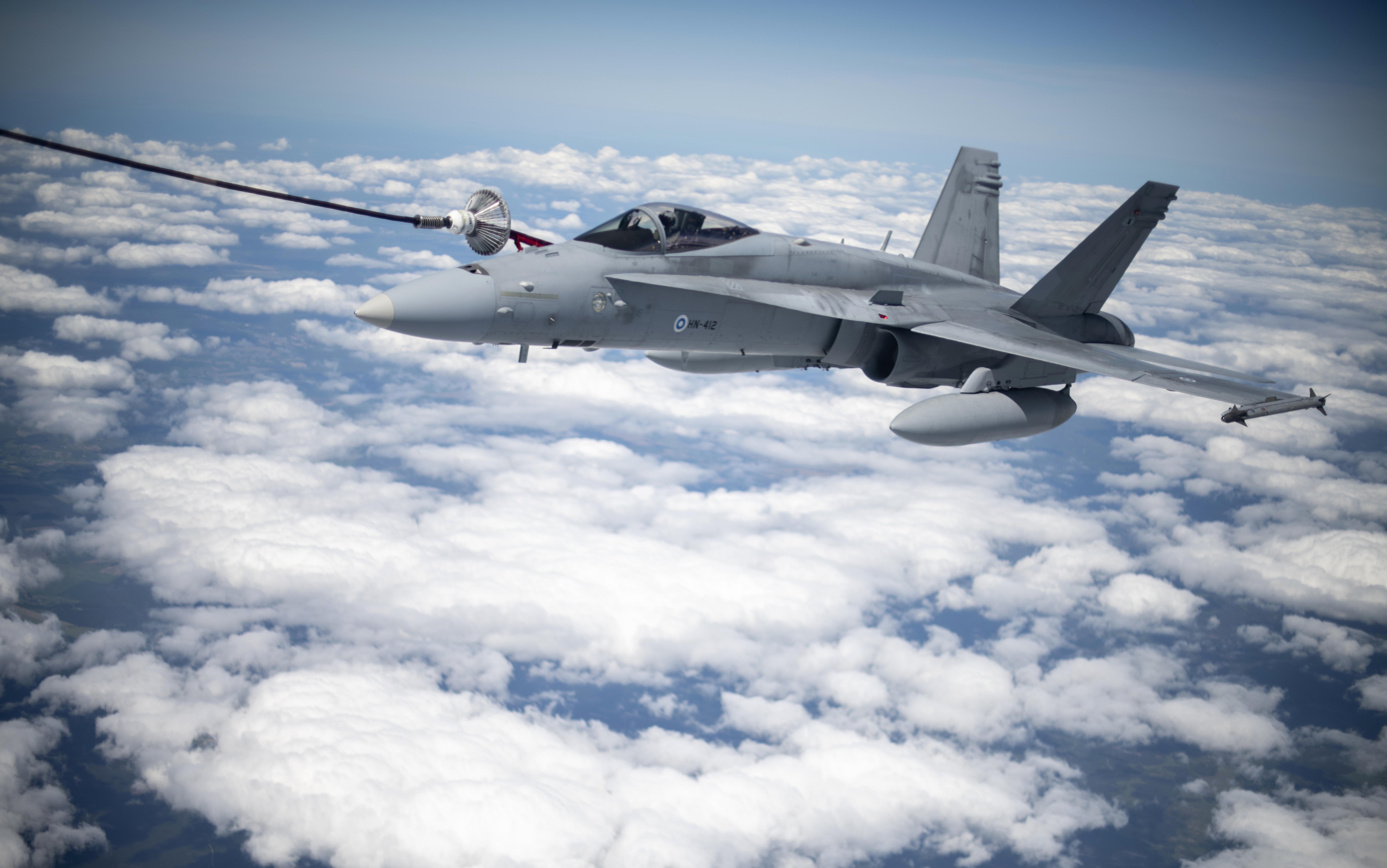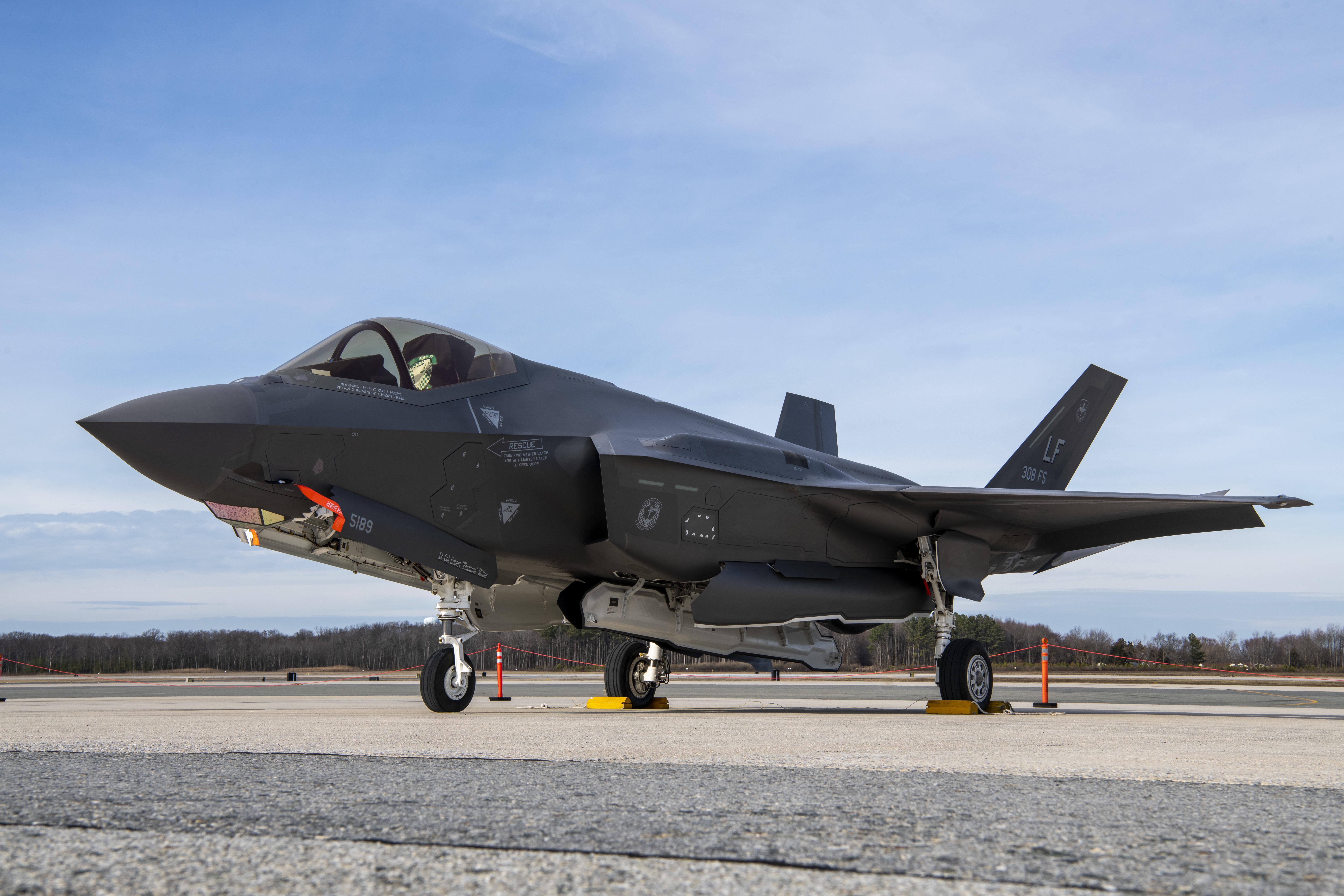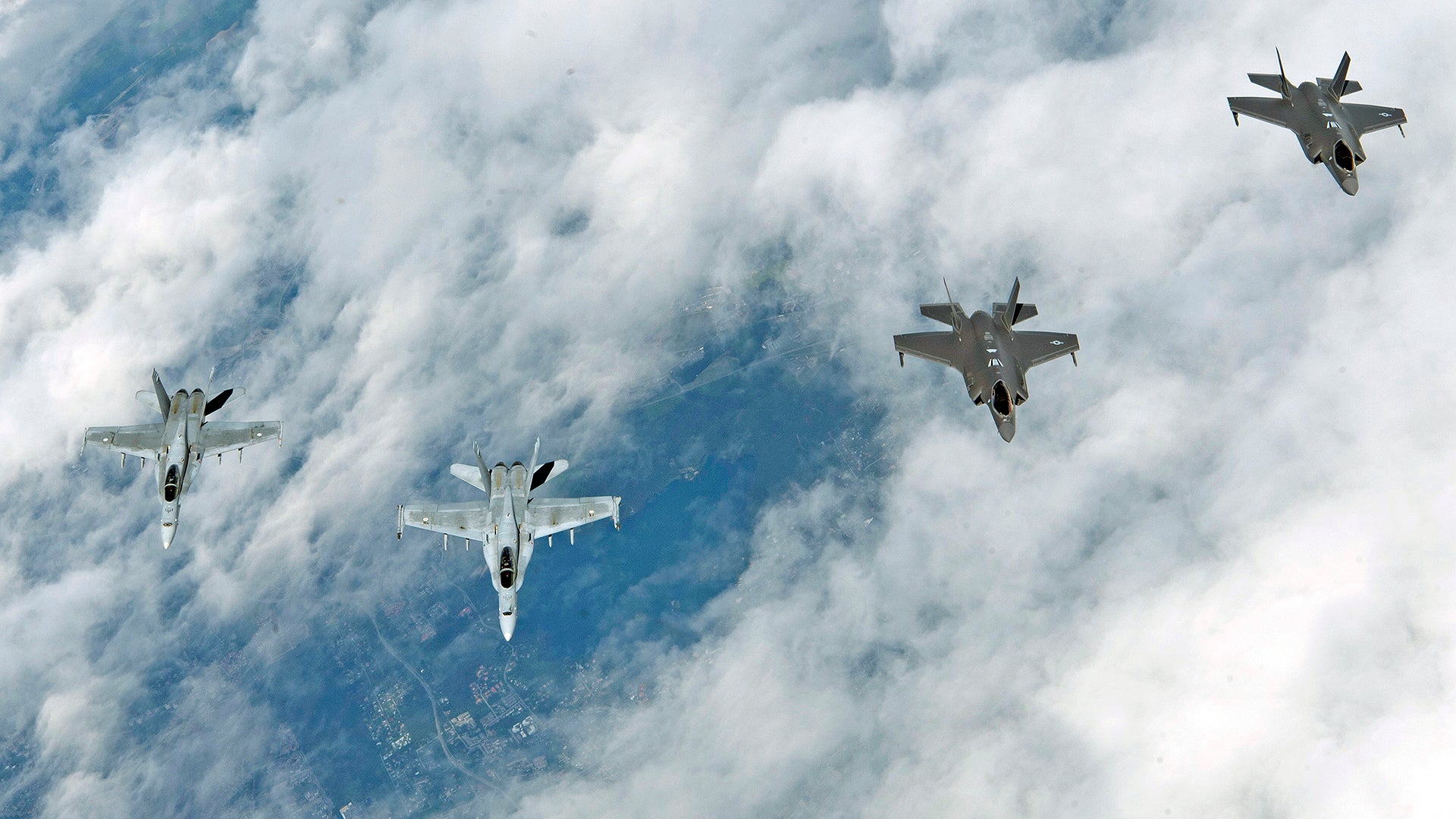The Department of Defense has announced details of two U.S. offers for Finland’s ongoing HX fighter competition. The first is for the Lockheed Martin F-35A Lightning II, while the second is a two-type package for the Boeing F/A-18E/F Super Hornet and EA-18G Growler.
The Defense Security Cooperation Agency issued notices that the U.S. State Department had approved the pair of potential Foreign Military Sales packages on Oct. 9, 2020. This does not mean that Finland has accepted either offer. The two U.S. manufacturers are among the five firms participating in the HX competition, which aims to replace the Finnish Air Force’s (Ilmavoimat’s) current fleet of upgraded F/A-18C/D ‘legacy’ Hornets — 55 single-seaters and seven two-seaters — by 2030.
Helsinki will make a final decision between these proposals, as well as offers from three European plane-makers: France’s Dassault, with the Rafale; the multinational Eurofighter consortium, offering the Typhoon, in a bid led by the United Kingdom; and Sweden, with the Saab JAS 39E/F Gripen. The Saab offering also includes the same company’s GlobalEye Airborne Early Warning and Control (AEW&C) aircraft.
It’s noteworthy that of the two American offers, that from Boeing exceeds the 10-billion-Euro price cap (approximately $12.8 billion) that Finland has placed on the HX tender, but Foreign Military Sales packages of these kinds can include more ancillary items and services than the recipient might eventually procure.
That the HX program is central to Finnish defense planning was made clear in August 2020, when it was announced that the 2021 budget proposal for the Finnish Ministry of Defence would amount to 4.87 billion Euros, or 54% more than the current budget, despite the fiscal uncertainties raised by the COVID-19 pandemic. “The increase is to a large extent due to the funding proposed to procure multirole fighters,” the Ministry of Defence confirmed.

The F-35 package for Finland has a total estimated cost of $12.5 billion and is based around the supply of 64 conventional take-off and landing F-35A variants. Also included are the following air-to-air missiles, air-to-ground precision-guided munitions, subsystems, and components:
Sixty-six (66) Pratt & Whitney F-135 engines (64 installed and 2 spares); five hundred (500) GBU-53/B Small Diameter Bomb II (SDB II) All-Up Round (AUR); twelve (12) GBU-53/B SDB II Guided Test Vehicles (GTV); twelve (12) GBU-53/B SDB II Captive Carry Vehicles (CCV); one hundred fifty (150) Sidewinder AIM-9X Block II+ (Plus) Tactical Missiles; thirty-two (32) Sidewinder AIM-9X Block II+ (Plus) Captive Air Training Missiles (CATMs); thirty (30) AIM-9X Block II+ (Plus) Sidewinder Tactical Guidance Units; eight (8) AIM-9X Block II Sidewinder CATM Guidance Units; one hundred (100) AGM-154C-1 Joint Stand Off Weapon (JSOW-C1) Tactical Missiles; two hundred (200) Joint Air-to-Surface Standoff Missile-Extended Range (JASSM-ER) AGM-158B-2 Missiles; two (2) AGM-158B-2 JASSM-ER Separation Test Vehicles; two (2) AGM-158B-2 JASSM-ER Instrumented Test Vehicles; two (2) AGM-158B-2 JASSM-ER Jettison Test Vehicles; two (2) AGM-158B-2 Inert JASSM w/Intelligent Telemetry Instrumentation Kits; two (2) AGM-158 Dummy Air Training Missiles; one hundred twenty (120) KMU-556 JDAM Guidance Kits for GBU-31; three hundred (300) FMU-139D/B Fuzes; two (2) KMU-556(D-2)/B Trainer JDAM Guidance Kits for GBU-31; thirty (30) KMU-557 JDAM Guidance Kits for GBU-31; one hundred fifty (150) KMU-572 JDAM Guidance Kits for GBU-38/54; one hundred twenty (120) BLU-117, General Purpose Bombs; thirty-two (32) BLU-109, General Purpose Bomb; one hundred fifty (150) BLU-111, General Purpose Bomb; six (6) MK-82, Inert Bomb; one (1) FMU-139D/B (D-1) Inert Fuze.
Perhaps surprisingly, no AIM-120 AMRAAM air-to-air missiles are included, although the Finnish Air Force is already well-stocked with these weapons, having ordered additional examples as part of the Mid-Life Upgrade 2 (MLU 2) for the Hornet fleet, that was undertaken between 2012 and 2016. Other weapons found in this proposed sale that were added the Hornets as part of MLU 2 effort are the JDAM, JSOW, and JASSM.

Also included in the complete package are:
Electronic Warfare Systems; Command, Control, Communications, Computer and Intelligence/Communications, Navigational, and Identification (C4I/CNI); Autonomic Logistics Global Support System (ALGS); Operational Data Integrated Network (ODIN); Air System Training Devices; Weapons Employment Capability and other Subsystems, Features, and Capabilities; F-35 unique infrared flares; reprogramming center access; F-35 Performance Based Logistics; software development/integration; aircraft ferry and tanker support; Detector Laser DSU-38A/B, Detector Laser DSU-38A(D-2)/B, KMU-572(D-2)/B Trainer (JDAM), 40 inch Wing Release Lanyard; GBU-53/B SDB II Weapon Load Crew Trainers (WLCT); GBU-53/B SDB II Practical Explosive Ordnance Disposal System Trainers (PEST); AGM-154C-1 JSOW Captive Flight Vehicles; AGM-154C-1 JSOW Dummy Air Training Missiles; AGM-154C-1 JSOW mission planning, integration support and testing, munitions storage security and training, weapon operational flight program software development; integration of the Joint Strike Missile; weapons containers; aircraft and munitions support and test equipment; communications equipment; provisioning, spares and repair parts; weapons repair and return support; personnel training and training equipment; weapon systems software, publications and technical documents; U.S. Government and contractor engineering, technical, and logistics support services; and other related elements of logistical and program support.
Meanwhile, the Boeing package, which is formally billed as being for the F/A-18E/F, despite including the EA-18G, has an estimated price tag of $14.7 billion. It is based around 50 single-seat F/A-18E and eight dual-seat F/A-18F Super Hornets, plus 14 EA-18G Growler electronic attack aircraft.
Last year, Dan Gillian, the head of Boeing’s F/A-18E/F and EA-18G programs told The War Zone that the combination of Super Hornets and Growlers made the company’s offer to Finland particularly strong. “We think that’s a great combination for Finland given the threat environment they operate in,” he said, referring to the Nordic country’s increasingly tense relationship with Russia.
Alongside these jets, Boeing’s proposal includes:
One hundred sixty-six (166) F414-GE-400 engines (144 installed and 22 spares); five hundred (500) GBU-53/B Small Diameter Bomb II (SDB II) All-Up Round (AUR); twelve (12) GBU-53/B SDB II Guided Test Vehicles (GTV); twelve (12) GBU-53/B SDB II Captive Carry Reliability Trainers; one hundred fifty (150) AIM-9X Block II Sidewinder Tactical Missiles; thirty-two (32) AIM-9X Block II Sidewinder Captive Air Training Missiles (CATMs); thirty (30) AIM-9X Block II Sidewinder Tactical Guidance Units; eight (8) AIM-9X Block II Sidewinder CATM Guidance Units; one hundred sixty (160) AGM-154C-1 Joint Stand Off Weapons (JSOW); two hundred (200) AGM-158B-2B Joint Air-to-Surface Standoff Missile Extended Range All Up Rounds (JASSM ER AUR); two (2) AGM-158B-2 JASSM Separation Test Vehicles (STV); two (2) AGM-158B-2 JASSM Instrumented Test Vehicles (ITV); two (2) AGM-158B-2 JASSM Jettison Test Vehicles (JTV); two (2) AGM-158B-2 Inert Joint Air-to-Surface Standoff Missile (JASSM) with Telemetry Instrumental Kits; two (2) AGM-158B-2 JASSM Maintenance Training Missiles (DATM); one hundred twenty (120) BLU-117B/B 2000LB GP Bombs; one hundred twenty (120) KMU-556F/B Bomb Tail Kits (JDAM); three hundred (300) FMU-139D/B Fuzes; two (2) KMU-556(D-2)/B Trainers (JDAM); thirty (30) BLU-109C/B 2000LB Bombs; thirty (30) KMU-557F/B Bomb Tail Kits (JDAM); two (2) BLU-109(D-1)/B 2000LB Bombs; one hundred two (102) BLU-111B/B 500LB General Purpose Bombs; one hundred two (102) KMU-572F/B JDAM Bomb Tail Kits; six (6) MK-82-0,1 500LB, General Purpose Bombs, Inert; fifty-one (51) BLU-110B/B 1000LB General Purpose Bombs; fifty (50) KMU-559F/B Bomb Tail Kits; fifty-eight (58) M61A2 20MM Gun Systems; thirty-two (32) Advanced Targeting Forward-Looking Infrared (ATFLIR); thirty-two (32) Sniper Targeting Pods; fourteen (14) Advanced Electronic Attack Kit for EA-18G; sixty-five (65) AN/ALR-67(V)3 Electric Warfare Countermeasures Receiving Sets; sixty-five (65) AN/ALQ-214 Integrated Countermeasures Systems; seventy-four (74) Multifunctional Information Distribution Systems – Joint Tactical Radio Systems (MIDS JTRS); eighty-nine (89) Joint Helmet Mounted Cueing Systems (JHMCS); three hundred seventy-seven (377) LAU-127E/A Guided Missile Launchers; seventy-four (74) AN/AYK-29 Distributed Targeting Processor – Networked (DTP-N); twenty-five (25) Infrared Search and Track (IRST) Systems; and eight (8) Next Generation Jammer Mid-Band (NGJ-MB) sets.
As in the F-35 offer, AIM-120 air-to-air missiles are absent, but as already noted Finland already has substantial AMRAAM stocks.
Also included in the proposed deal are:
AN/APG-79 Active Electronically Scanned Array (AESA) radars; High Speed Video Network (HSVN) Digital Video Recorder (HDVR); AN/AVS-9 Night Vision Goggles (NVG); AN/AVS-11 Night Vision Cueing Devices (NVCD); AN/ALE-47 Electronic Warfare Countermeasures Systems; AN/ARC-210 Communication System; AN/APX-111 Combined Interrogator Transponder; AN/ALE-55 Towed Decoys; Launchers (LAU-115D/A, LAU-116B/A, LAU118A); AN/AAQ-28(V) Litening Targeting Pod; Joint Mission Planning System (JMPS); Accurate Navigation (ANAV) Global Positioning System (GPS) Navigation; Aircraft Armament Equipment (AAE); Aircraft Ferry transportation; Foreign Liaison Officer (FLO) Support; Auxiliary Fuel Tanks, FMU-139D(D-2)/B fuzes; MK84-4 2000LB General Purpose Inert Bombs, MK83 Bomb General Purpose Inert Bombs; KMU-557C(D-2)/B tail kits; KMU-572C(D-2)/B tail kits; Detector Laser DSU-38A/B, Detector Laser DSU-38A(D-2)/B, KMU-559C(D-2)/B load trainer; Wing Release Lanyard Assemblies; AGM-154C-1 JSOW Captive Flight Vehicles, Dummy Air Training Missiles, AGM-154C-1 JSOW mission planning, integration support and testing, munitions storage security and training, weapon operational flight program software development; weapons containers; aircraft and munitions support and test equipment; communications equipment; provisioning, spares and repair parts; weapons repair and return support; personnel training and training equipment; weapon systems software, publications and technical documents; U.S. Government and contractor engineering, technical, and logistics support services; and other related elements of logistical and program support.
Finland has made it clear that the above notification procedure is necessary in order to authorize the possible sale of either the F-35 or F/A-18E/F and does not constitute a procurement decision. The Finnish government has been at pains to emphasize clarity and fairness throughout the HX competition, for which a tendering phase began in spring 2018. Back then, the Finnish Defence Forces’ Logistics Command sent a preliminary invitation to negotiate and a request for quotations (RFQ). Responses to the RFQ were received in January 2019, after which the first phase of negotiations could begin.
Then, around a year ago, on October 31, 2019, the Logistics Command sent a Revised Request for Quotation (RFQ) for the HX Programme to the five competing companies. The last call for responses was January 31, 2020. According to the Logistics Command: “This call for tenders is a continuation of the negotiations that have already taken place. With the more detailed call for tenders, each tenderer is requested to compile the information provided in its initial tender and negotiations into a clear, updated and improved package.”
As to what Finland is looking for in its next multirole fighter, the government has been explicit in its selection criteria, which are based on five considerations: military capability, security of supply, industrial cooperation, procurement and life-cycle costs, and security and defense policy implications.
At the end of the second phase of negotiations, sometime before the end of 2020, a request for the best and final offer is expected to be sent out.
This final offer will have taken into account the conclusions from the so-called HX Challenge that took place at Finland’s Pirkkala Air Base near Tampere from January 9 to February 26, 2020. This “testing and evaluation event” saw each of the five candidate jets undergo a seven-day test period under typical Finnish conditions.

“The HX Challenge is the first stage of the capability assessment,” explained Colonel Juha-Pekka Keränen, the Finnish Air Force’s HX Programme Director. “The aim of the testing and evaluation event is to verify that each candidate’s systems and performance values match the data reported by the manufacturers.”
“The second phase of the capability assessment will make use of the data and performance values established during the HX Challenge. Carried out with virtual simulators, this phase focuses on determining the success of a flight of four aircraft in the scenarios itemized in the call for tenders.”
“The third phase will demonstrate the operational efficiency of each candidate’s comprehensive HX solution by playing and simulating a long-term war game. The data obtained in the first two phases of the capability assessment will be utilized in the war game, which will feature the HX solutions as a part of Finland’s defense system.”
A decision on the winning fighter is due in 2021, and the aircraft selected is expected to continue in service into the 2060s.
With the Joint Strike Fighter having so far emerged successfully from each of the fighter competitions that it’s been judged in, it might be the F-35’s contest to lose. On the other hand, its experience with the existing F/A-18C/D fleet would make a switch to the Super Hornet for Finland more straightforward, reducing costs for infrastructure and training, and allowing a more rapid transition.
Finland, which is outside NATO, has a long history of taking a different approach to its defense procurement and the HX competition might yet throw up a surprise.
Contact the author: thomas@thedrive.com
